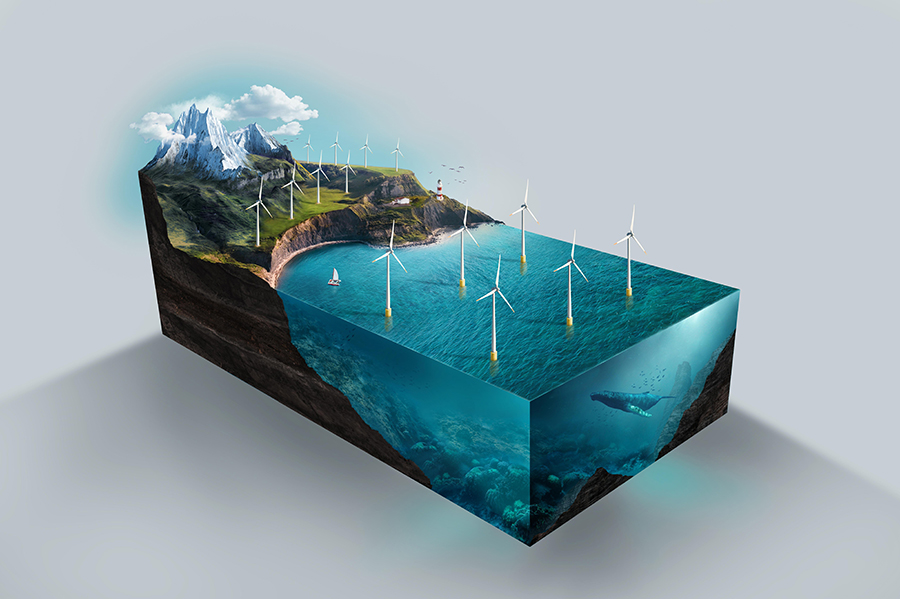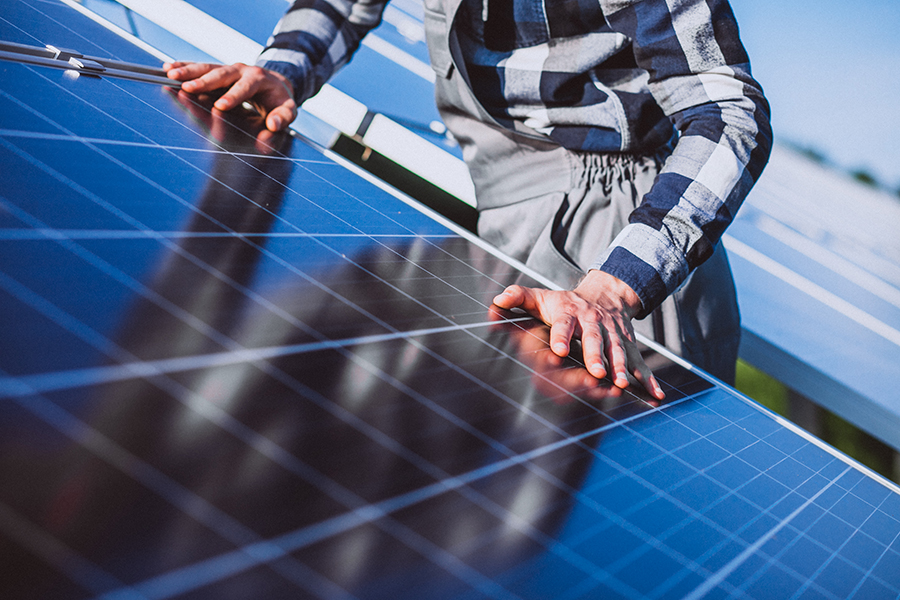The Inflation Reduction Act set the stage for explosive solar and wind energy growth.
To slash U.S. emissions of climate-warming carbon pollution, many experts have settled on a plan that can be largely described in two steps: Clean up the power grid and electrify everything.
If electric vehicles, heat pumps, induction stoves, and some industrial processes can be powered by clean electricity and replace fossil-fueled alternatives, that transition will do most of the work toward decarbonizing the economy and helping the U.S. meet its commitments under the Paris climate agreement.
Carbon pollution from the U.S. power sector had already been declining, albeit too slowly to meet the country’s Paris commitments. Then in 2022, President Biden signed into law the Inflation Reduction Act, which includes over a decade’s-worth of tax credits for clean electricity sources. That financial certainty along with the rapidly falling costs of solar and wind power and energy storage are set to unleash an explosion of clean-energy deployment in the coming years.
A plethora of energy modelers and renewables and financial experts have published reports and studies projecting just how quickly this transition will occur. The consensus is that the amount of solar and wind generation in the U.S. will nearly double between now and 2025 — and then nearly double again by 2030, supplying about half the country’s power by the turn of the decade.
But a variety of complicating factors create uncertainty around that precise number, and it’s still not enough to meet the U.S. Paris commitment to reduce its carbon pollution to net zero by 2050.
Breaking clean energy records every year from now on
2021 was a record year for clean energy installations in the U.S., with about 13 gigawatts of wind and nearly 24 gigawatts of solar power capacity installed. Those numbers dipped a bit in 2022 due largely to supply chain issues but have begun to rebound in 2023. Experts expect their growth to continue, with supply chain issues largely resolved and the Inflation Reduction Act’s clean energy tax credits now available.
A recent study published in the prestigious journal Science looked at the clean energy growth forecasts from nine energy systems models, including those from groups at Princeton, Energy Innovation, Rhodium, and the National Renewable Energy Laboratory. To gauge the Inflation Reduction Act’s impact, the models were run with scenarios in which the bill did not become law, then compared to the model forecasts of a post-Inflation-Reduction-Act world.
The U.S. currently generates about 40% of its electricity from low-carbon sources, including 18% from nuclear power, 10% from wind, 6% from hydropower, and 5% from solar. The models projected that even in the absence of the Inflation Reduction Act, those numbers would grow to about 50% clean electricity in 2025, 55% in 2030, and almost 60% in 2035 simply due to the growth of cheap solar and wind.
But when the Inflation Reduction Act’s clean energy tax credits are factored in, solar and wind energy growth are supercharged. In this new reality, the models forecast that the U.S. low-carbon electricity numbers will grow to 54% in 2030, 73% in 2030, and over 80% in 2050. That includes a near-doubling of solar and wind generation from 15% of U.S. electricity to about 28% in 2025, 50% in 2030, and 60% in 2035.
Most of that growth will likely come from new utility-scale solar farms, thanks to their plummeting costs. Forecasts from the Energy Information Administration, Morgan Stanley, and a joint analysis by Wood Mackenzie and the Solar Energy Industries Association all project that the U.S. will install about 63 gigawatts of new solar capacity by the end of 2024. The Federal Energy Regulatory Commission similarly identified 78 gigawatts of solar and 20 gigawatts of wind power with a high probability of being built by mid-2026, with the potential for much more. The commission projects that nearly 90% of new energy capacity added during the next three years will be low-carbon and that more fossil fuels may be retired than are added to the grid during that time.
In short, the record 24 gigawatts of solar capacity added in 2021 will likely be broken in 2023 — and in every subsequent year for the foreseeable future.
Factors that could slow the clean energy transition
But some roadblocks remain that create uncertainty about just how fast the U.S. will build all of this new clean power. Inadequate electrical transmission infrastructure is chief among them and the subject of ongoing permitting reform negotiations in Congress.
As of this writing, there’s more power stuck in the “interconnection queue” than exists on the entire power grid. These are projects awaiting an assessment regarding whether the grid can handle their added power, or whether the developers would need to pay to build more grid capacity. Under today’s conditions, it takes a decade on average to build a new electrical transmission line in the U.S.
An analysis by energy modelers at Princeton found that if the U.S. continues to build out transmission infrastructure at the recent slow rate of 1% to 1.5% expansion per year, 50% to 80% of the Inflation Reduction Act’s potential climate pollution cuts could be squandered because of the inability to connect new clean energy to the grid. Doubling that rate from 1% to 2% per year would more than double the solar and wind energy that could be built. Congress and the Federal Energy Regulatory Commission are working on measures to speed up that transmission infrastructure build-out, but it remains to be seen how successful these efforts will be.
Changes in net-metering policy in California that will reduce the payback by 75% for sending extra solar energy back to the grid are also expected to slow the deployment of residential installations in the state, which ranks No. 1 for installed rooftop solar. And the Biden administration’s temporary suspension of tariffs on solar panels imported from China and Southeast Asia is set to expire in June 2024, which could result in higher solar panel prices and thus could somewhat hinder their deployment.
A bright future for clean energy
Although these factors create some uncertainty around exactly how fast U.S. solar and wind energy will grow, there is nevertheless a consensus among experts that their deployment will proceed at a record-breaking pace. Solar and wind power are forecast to generate between about 35% and 55% of domestic electricity by 2030 and 45-65% by 2035. Other low-carbon sources like nuclear power and hydroelectricity will likely account for a further 25% of power generation.
But without additional policy measures, energy models project that this progress will only reduce U.S. climate pollution by 33% to 40% below 2005 levels by 2030, reaching 43% to 48% emissions cuts by 2035. That’s about 10 percentage points closer to meeting the U.S.’s Paris commitment to curb climate pollution 50% below 2005 levels by 2030 than the country’s pre-Inflation Reduction Act path, but additional action will be needed to meet that target.
Dana Nuccitelli, research coordinator for the nonprofit Citizens’ Climate Lobby, is an environmental scientist, writer, and author of ‘Climatology versus Pseudoscience,’ published in 2015. This story originally appeared at Yale Climate Connections and is republished here as part of Covering Climate Now, a global journalism collaboration strengthening coverage of the climate story.






